It was our second day in China, and it was going to be a busy one. We had arranged a day tour with The China Travel Company, and it had a packed itinerary, visiting the Temple of Heaven, Tiananmen Square, the Forbidden City and the Summer Palace. Our tour guide and the driver picked us up from the hotel at 8.30 a.m. and we were off.
Our first stop was at the Temple of Heaven. This temple complex was constructed from 1406 to 1420 during the reign of the Yongle Emperor (who also built the Forbidden City). We entered through the temple East Gate, and walked along the long corridor. In the olden days, this corridor was used for taking animals to the temple for sacrificial offerings. Today, the corridor and the park surrounding it is a popular hangout for locals. We saw many (mostly older) people playing cards and doing Tai Chi.

At the end of the long corridor, is a very large courtyard, at the centre of which is the Hall of Prayer for Good Harvests. This is the main building of the temple. It is a gigantic circular building, ~36 meters in diameter and 38 meters tall, built on three levels of marble base. Despite the large structure, the building is entirely made of wood with no nails. The original building was burned down by a fire in 1889, and it was rebuilt, so the currently building is a little over a 100 years old. It is a splendid building, standing on its own in the centre of the courtyard, looking up to the heavens.

The main colours of the building are blue, yellow and green, which our guide explained were the colours for heaven (blue), yellow (royalty) and green (earth). The colours of the temple were fresh and vibrant in the morning sunlight – our guide told us that they had been restored prior to the Beijing Olympics in 2008.

After admiring the building it from the outside, we went to the main entrance for a closer look. You can’t go inside the hall, but view it from the entrance gate. Despite it not being 9.00 a.m. yet, it was pretty busy, but we managed to squeeze past the throngs of people and take a peek inside. Inside there are several large heavily decorated columns (all made of wood). The other entrances to the hall were closed, so it was a bit gloomy inside.

After a quick look at some of the surrounding buildings (one of which was a museum) we continued on to our next destination.

Although we got here by car, you can get to the Temple of Heaven using public transport – it is on Subway line 5. Tickets cost from 10 to 30 Yuan, depending on type of ticket and when you visit. You can find more details here
On the way, we had a short stop at a silk store. This was interesting, as we got to see the many stages of silk making – different type of silkworms used, how the threads are extracted and how silk quilts are made.


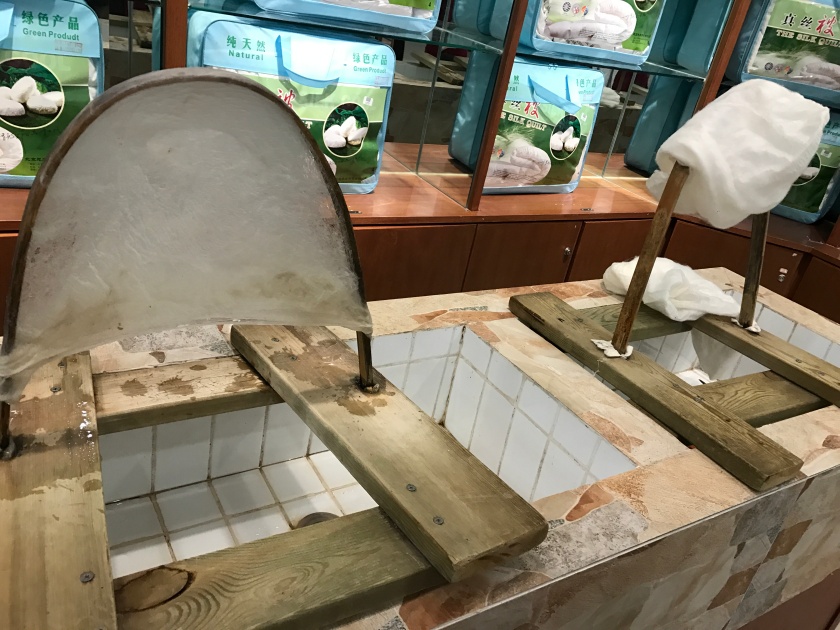
The demonstration ended with us being led to a large silk shop, which had everything imaginable made from silk, with prices ranging from 100 Yuan to several thousand. We bought a couple of scarves as souvenirs, at 160 Yuan, which came with an authentication certificate. Later in the trip, we would see similar scarves for a lot cheaper in Xian and Shanghai. Moral of the story is that if you want to buy authentic 100% silk, go to government approved store like this. But if you are after a nice scarf and don’t really mind if it is 100% silk or not, they you are better off shopping in the markets. Also in the markets you can (or rather have to) haggle, but in a store like this the price you see if the price you pay. Day trips in China are notorious for these “shoppertunities”. The guides usually get a commission and some people dislike the gentle pressure to purchase something. We didn’t mind the shoppertunity, as we found the demonstration interesting and once we had enough of looking around the shop we simply walked out and went to the car where the guide and drover were waiting for us.
Our next stop was the famous Tiananmen Square, which is one of the largest public spaces in the world and home to many historical events. The square is surrounded on the four sides by Chairman Mao’s mausoleum, The Hall of the People (which is the seat of the Chinese congress), the Museum of China and Tiananmen gate. There is also the people memorial in the middle which contains Chairman Mao’s writing.

The square name is derived by the Tiananmen gate (meaning gate of “Heavenly Peace”), which is also the south entrance to the Forbidden City. The square still had decorations from the national holiday celebrations few weekly previously. After taking plenty of pictures in Tiananmen square we entered the forbidden city through the south gate.
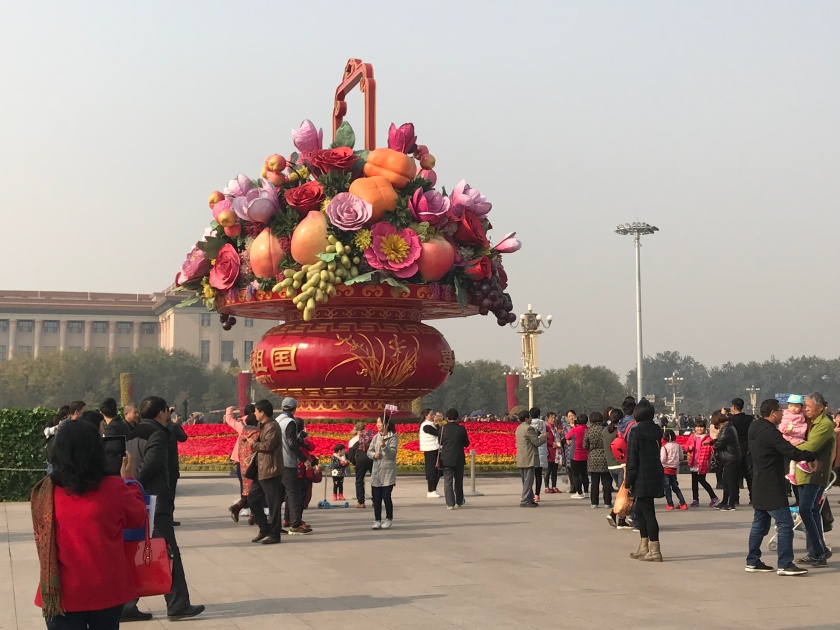
Forbidden city is what I had looked forward to visiting the most today. I had read Anchee Min’s “Empress Orchid”, which chronicled the life of Empress Cixi who later became the famous empress Cixi. The booked contained vivid descriptions of the Forbidden City, so I was looking forward to seeing the real thing.
The forbidden city was constructed by the Yongle emperor in early 1400s. Construction is said to have taken 14 years and more than a million workers.
After walking underneath the imposing Tiananmen gate, you buy tickets and enter the forbidden city through the Meridian Gate, where there is a ticket check and a security check.

Beyond the meridian gate is another large courtyard, with a small stream and five bridges crossing it. The shape of the stream and the bridges is meant to resemble a drawn bow and arrow. This is the Golden Waters Bridge.

Following this we went through the gate of Supreme Harmony, beyond which is the Hall of Supreme Harmony. This is where the emperor used to grant audiences to his subjects.

It was a Sunday, and forbidden city was busy (but not heaving). 90% tourists there were local tourists, which we were told were from other parts of China. The layout of Forbidden city was similar to the Lama temple we visited the previous day. The main buildings were located along the central axis with many smaller buildings on the side. You can’t go inside any of the halls, but it is possible to peek inside from the entrance gate.

The large spaces, imposing buildings the giant wooden pillars and the marble tablet were designed to express the might of the emperor and still impresses today. We also saw many large copper vats, which were for hold water to put out any fires. This was understandable as most of the forbidden city buildings were made from wood.

We went through a few more gates and pavilions used by the emperor for various official functions. These gates, pavilions and archways consist of the outer palace. Beyond the outer palace is the inner palace, which was the living quarters of the emperor his family. The palaces are divided in to the Western Palace and Eastern Palace with the Palace of Heavenly Purity in the middle.

We walked through the Eastern Palace, which contained a number of smaller buildings used to house the many of the emperor’s concubines. Compared to the outer courtyard and the buildings on the central axis, these buildings were small and cramped together.

They also had high walls encircling them, which gave it a claustrophobic feel. However in the winter I’m sure these would have been cosy and comfortable to live-in compared to the large and draughty halls in the outer courtyard. It is also possible go inside some of these buildings.


Beyond the inner palace is the comparatively small garden, with a small artificial hill sculpture.


At the end of the garden is the forbidden city exit through north gate – the great of divine prowess.
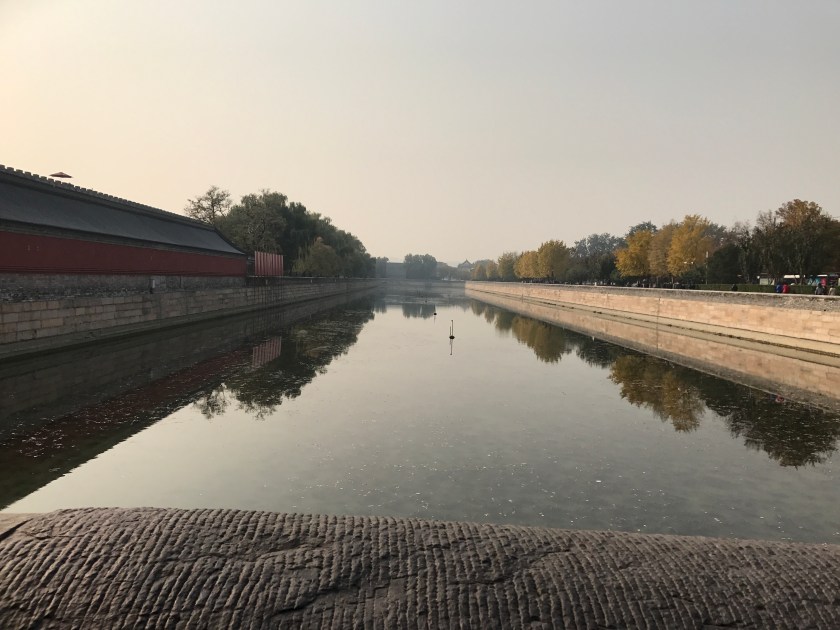

The forbidden city is surrounded by the man made Tongzhi moat. Behind the forbidden city there is an artificial hill made from the earth excavated from digging the moat.

We crossed the moat and got in the car to head to our next destination.
Although we came to the forbidden city with our guide, it is possible to visit on your own. Subway lines 1 and 2 to serve Tiananmen square, and it is a short walk to the forbidden city from there. All the places of interest are sign posted in English so you can enjoy the forbidden city at your own leisure.
On the way to the summer palace, we stopped for lunch. The lunch was provided for us as part of the day tour. The restaurant was in one of the Beijing suburbs and catered to tour groups.

There were several groups there when we arrived. The lunch was a typical Chinese meal with several dishes and rice. After finding out that my mother was vegetarian, our guide had called ahead to adjust the standard menu so that there will be more vegetarian dishes than usual.

After lunch, we headed to the summer palace which took about 30 minutes.
The summer palace – is exactly what it says on the tin. It served as the emperor’s palace during summer when the forbidden city was too hot to live in.


In 1860, the summer palace was looted by the French and British troops in response to the torture and killing of two British envoys, a journalist for the Times and their escorts. The summer palace was restored following this incident. Between 1884–95, Empress Dowager Cixi ordered the summer palace to be reconstructed and enlarged to celebrate her 60th birthday. This was controversial as the money used was earmarked for upgrading the navy.
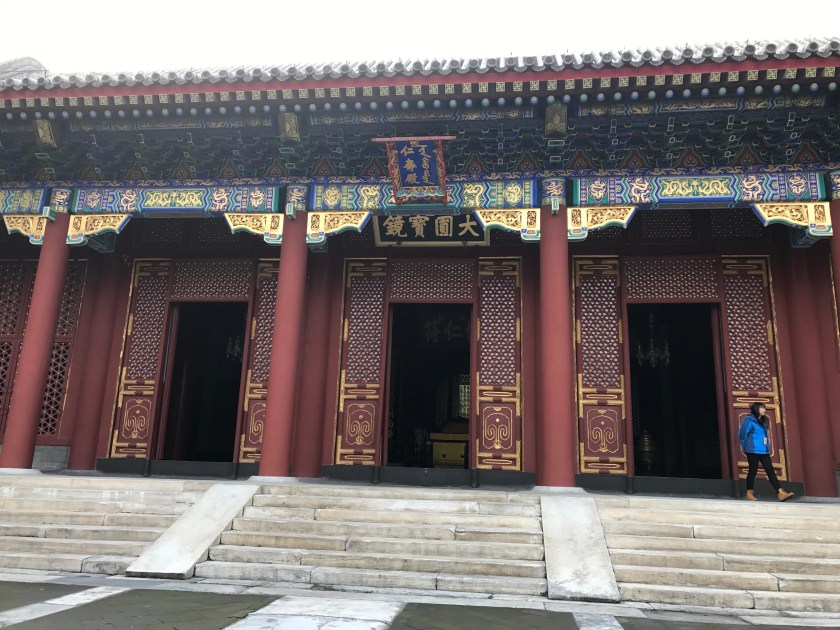
It’s a beautiful park with many pavilions, sculptures and walk ways. The main feature of the park is the kungming lake.
 The summer palace is also home to the long corridor which is one of the longest outdoor corridors in the world. Story goes that Empress Cixi had built so she could be sheltered from the rain as she was taken in her sedan chair for a her evening walk.
The summer palace is also home to the long corridor which is one of the longest outdoor corridors in the world. Story goes that Empress Cixi had built so she could be sheltered from the rain as she was taken in her sedan chair for a her evening walk. At the end of the long corridor, there is large, stationary boat made of marble. This is a replica of a previous wooden boat which had burnt down. The empress used to take her afternoon tea here.
At the end of the long corridor, there is large, stationary boat made of marble. This is a replica of a previous wooden boat which had burnt down. The empress used to take her afternoon tea here.

On the upper floor of the boat, there is a large mirror. apparently the empress would drink tea with her back to the lake, whilst looking at the reflection of the lake and the sunset in the mirror.
We also saw a large theatre in the summer palace. This is a large, 3 level theatre, which held performances of Peking opera for the emperor and his court.

You can also see where the audience used to sit, and some of the furniture and soft furnishings dating back to the time of the last empress. You need to pay extra for this part of the summer palace, but I felt that this was worth it.
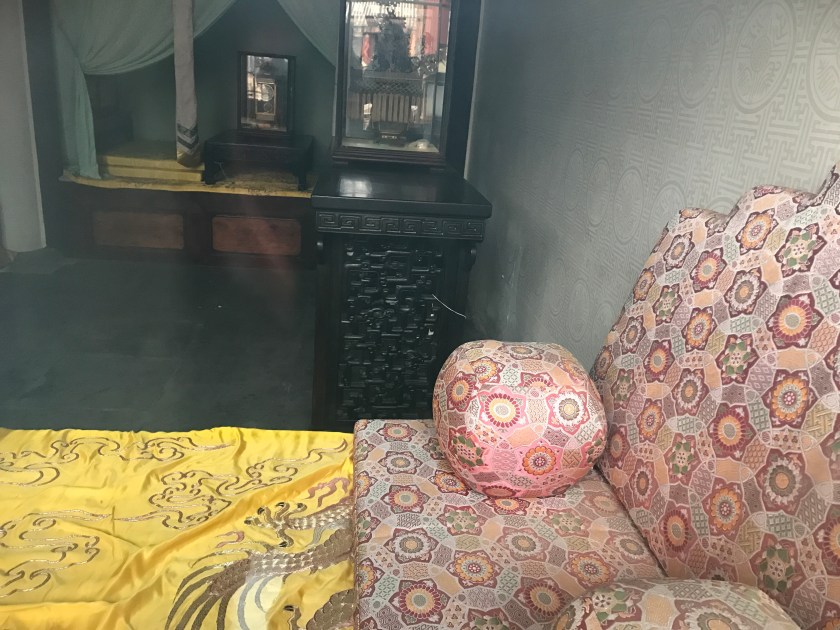
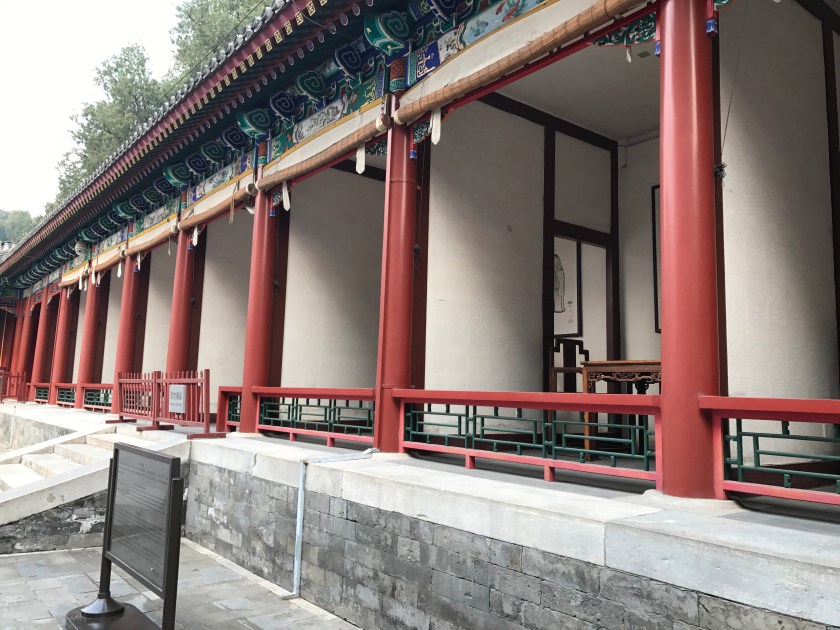
There were several other places included in this extra ticket, but these had closed by the time we got there. We left the summer palace as darkness was closing in and got back to the hotel via the centre of Beijing.

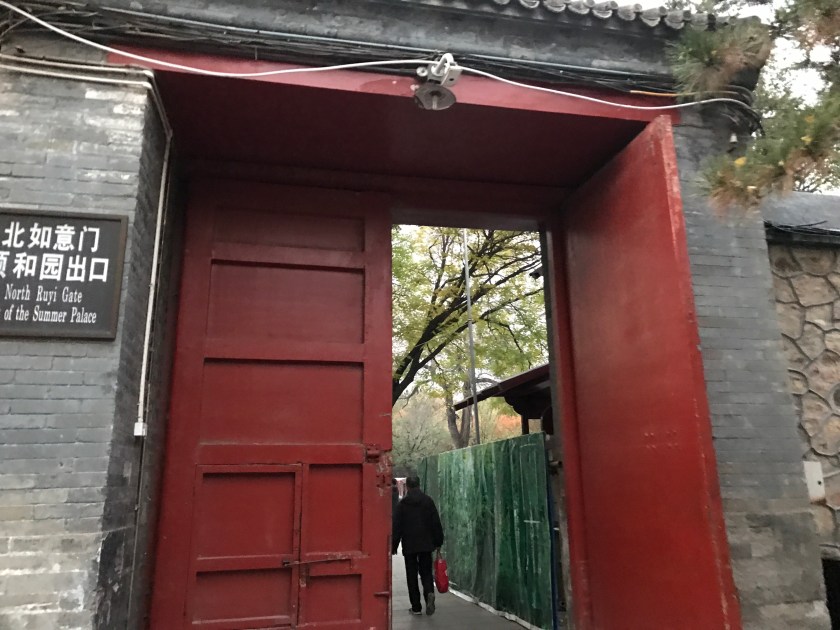

Reflections on Day 2: It was no doubt a great day, and I ticked off so many things off my bucket list. In hindsight though, it would have been better to split this over two days, as there was so much to see. A better itinerary would be to visit Tiananmen square, Mao Mausoleum and Forbidden City on the first day and spend the second day visiting the Temple of Heaven and Summer Palace.
Linking up to #theweeklypostcard

Beijing is the capital of China. The Great Wall which is known by people all the world is located in Beijing, China. It is a popular tourist place all over the world. The Forbidden City, The Summer Palace and Temple of Heaven are the top tourist places in Beijing. Every traveller has the dream of going to Beijing. Last year I had travelled to only Beijing with the help of beijingtransfertour.com. Their travel agents were very polite and friendly. They provided me with good service.
LikeLiked by 1 person
Thanks so much for linking. Always great to get a mention!
LikeLike
Yeah I agree with you that the itinerary should have split over two days. My parents and sister had been to Beijing and they had mentioned to me that the Forbidden Palace is huge and there’s so much to see. Agree with you as well on shopping at government-approved shops – I hate haggling, so I prefer fixed prices even though the prices are relatively higher than from the streets. At least I’m guaranteed of a genuine product 🙂 #TheWeeklyPostcard
LikeLiked by 1 person
Great to read this and see the photos. Brings back a lot of good memories. We visited in 2008 and did split those particular places along with the Olympics venues and the Great Wall across three days which gave us a bit more time in each. Absolutely loved the Temple of Heaven when we were there; it was so full of life and energy with the dancing, singing, games-playing, exercising, etc. in every direction we looked.
LikeLiked by 1 person
Thanks! I really enjoyed our time there, but I agree, 3 days would have been a better option.
LikeLike
China is such a fascinating country and I would love to visit one day! It was the one trip my parents never took me on and I don’t know if I could ever forgive them for that! 😉 Your post seems like the exact same trip they took though so now I can see more of what they saw! Happy New Year! #TheWeeklyPostcard!
LikeLiked by 1 person
Happy new year. There is so much to see in China! Well worth a visit!
LikeLike
I love the Forbidden City, I just couldn’t get over how big it was. I haven’t made it to the Summer Palace yet, so definitely want to go there on my next trip. It looks lovely. Thanks for sharing on #TheWeeklyPostcard
LikeLiked by 1 person
Summer palace is great, but I think between the two, the forbidden city is more unique and interesting, so you picked the right one to visit first! 🙂
LikeLike
Wow – very impressive!
LikeLiked by 1 person
I’m so glad you shared this post today! My husband and I are getting ready for a trip to China and I am avidly reading everything I can about this country. We were planning to visit the Forbidden City too and from all I read The China Travel Company seems like a good choice. Do you think we could attempt to visit China by ourselves, without a guide? #TheWeeklyPostcard
LikeLike
Glad to hear you are thinking of China – there is so much to see. You can do China without a guide, especially if you are doing the big cities Beijing, Xian or Shanghai. I’d recommend going with a guide for some of the biggest attractions like the forbidden city, great wall and terracotta warriors, for the convenience more than anything – they will navigate the ticket queues etc all for you and take the hassle away, but the rest of the time you can explore on your own. The underground system is good, train stations are well sign posted and hotel staff speak good English. We did a 7 day trip in China, but we only had guides for 3 of the days, plus transfer to/from airports and train stations. Rest of the time we walked around on our own and it was no problem. The China Travel Company is good, because you can mix and match exactly what you want. Please let me know if you have any further questions o China. More than happy to help 🙂
LikeLike